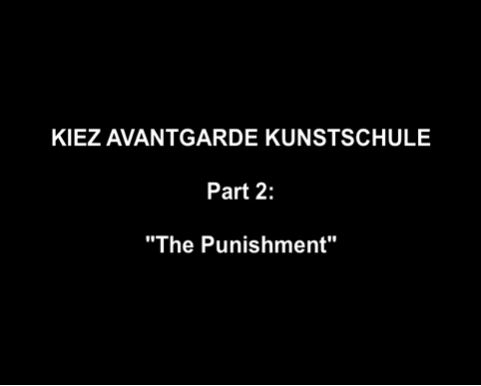

KIEZ AVANTGARDE KUNSTSCHULE, PART II: “The Punishment“
Kiez Avantgarde Kunstschule is a contemporary art project involving pre-teen children from Soldiner Kiez in Berlin, Germany. During a summer workshop, the artists Ondrej Brody (CZ), Ivars Gravleis (LAT), Kristofer Paetau (FIN) and Avdey Ter-Oganian (RUS) planned to introduce a group of children into the practice of contemporary art, thereby referring to the longtime project “School of Contemporary Art” initiated by Avdey Ter-Oganian with teenagers in Moscow in the 90s. Our project didn’t turn out as expected: We didn’t manage to find a steady group of children to work with, so we decided to go to the nearest playground in order to try to attract children to participate in this project. Moreover, we had continuous disagreements concerning the (pedagogical) content of our project, which at the end resulted in the fact that only two exercises, conceived by Kristofer Paetau (“Airplane Dripping” and “The Punishment”), were executed, since he was the only artist capable to communicate with the children in German…
A Quicktime Videodocumentation is to be viewed at:
http://www.paetau.com/downloads/KiezAvantgarde/ThePunishment.mov
„It is an illusion that youth is happy, an illusion of those who have lost it.“
W. Somerset Maugham

The second exercise starts with a Coca Cola and a question the artist seems to ask the children. Their arms are risen, they act like pupils in a real school. Someone is filming in the background. What‘s going on?
We had just arrived to my studio, where the children had carried the “Airplane Dripping“ painting they had made at the playing ground. Now I wanted them to do the second exercise: to “punish“ the official portrait of George W. Bush by spitting Coke on it. So I just asked them “who wants to drink Coca Cola?“...
„If you haven't turned rebel by twenty you've got no heart; if you haven't turned establishment by thirty you've got no brains!“
Kevin Spacey
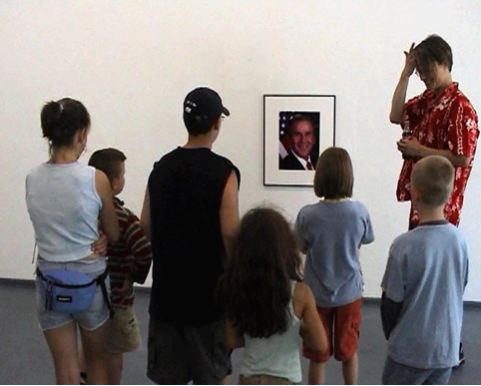
What were you talking about in front of the portrait?
First of all I asked them if they knew that person – and nobody knew his name... Then I told them the name and that he is the president of the United States. I also told them that he is stupid and a bad person.
„Looks like what drive me crazy have no effect on you. But, I'm going to keep at it. Till it drives you crazy too.“
James Mercer Langston Hughes
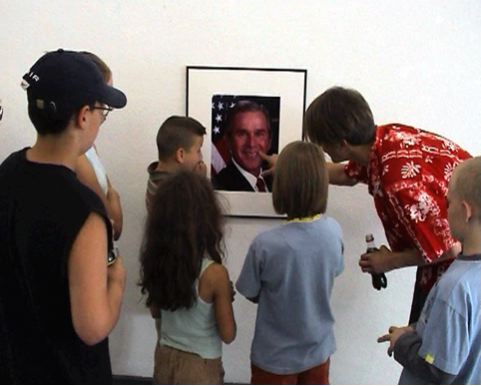
And what has it got to do with art?
The idea of this exercise was the punishment of a picture. I find this idea very interesting as an artistic gesture. How to punish a picture? Of course it wasn‘t just any picture, but the most obvious one for this purpose, in my opinion... So it was also about making ‘political art‘. A term that I generally dislike and can't identify with. But I was very excited about the idea of making the children produce this political ‘piece‘.
„I'm really appalled by plastic surgery in this country. We've got to make friends with those sags and wrinkles, as they represent our lifetime experience.“
Jane Fonda
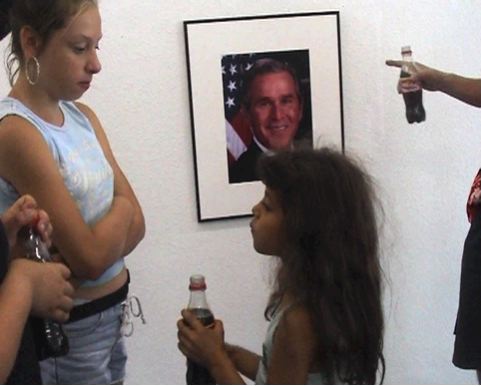
The tall girl seems to prove her opposite. Everyone has a Coca Cola in the hands, except her.
She was just well educated and remembered that her parents didn‘t want her to drink Coke or other drinks containing sugar. - I had told the children that this president of the United States has started wars and that many people have died because of him. That‘s why the children are looking quite serious, and nobody was speaking for a short moment...
„I don't say that we ought to all misbehave, but we ought to look as if we could.“
George Orson Welles
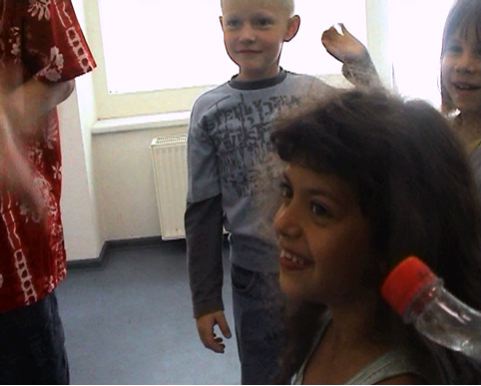
Tell me more about the development of your talk.
After telling all that, I said that this man merited to be punished, and I told them a couple of standard punishments as examples: to pull someone‘s hair, to hit someone on the fingers, etc. And the little girl (in the picture) was smiling and said that those were not big enough punishments... She proposed to slap his face or to put needles in his eyes. And the other children also got exited about the idea of putting needles in his eyes...
„For every problem, there is a solution that is simple, neat, and wrong.“
Henry Louis Mencken
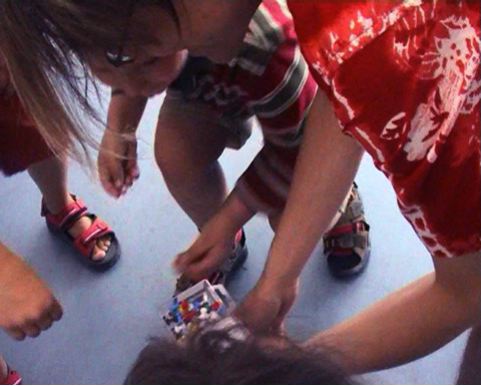
Then you brought the needles...
Luckily I had a package of very nice needles in my studio, so I brought them and the kids got very excited!
„Again I tell you, it is easier for a camel to go through the eye of a needle than for a rich man to enter the kingdom of God.”
Matthew 19:23-25
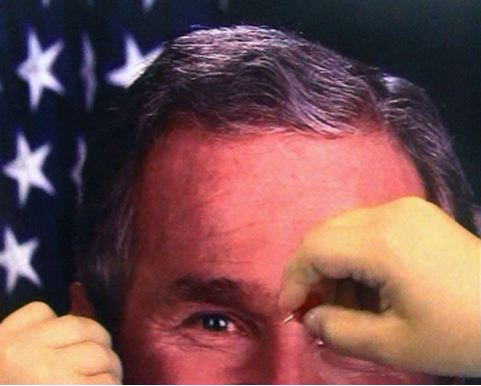
...and they started the action.
Yes, they were totally into it. It would have been very difficult to stop them at that moment... I was very surprised and delighted that they had actually invented a much more efficient, direct and cruel punishment than I had been capable of thinking of!
„Love is blind; friendship closes its eyes.“
Friedrich Wilhelm Nietzsche
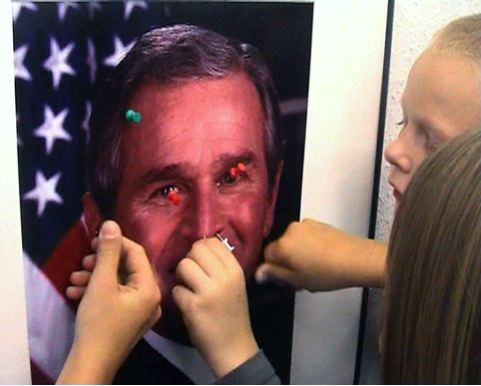
What do you think about your responsibility as an "art teacher" - curator, and what about the brutality of this action?
The charming little girl who had the idea of the needles actually told herself (after I proposed to hand them needles) that, “it‘s only a picture“, to justify the action they would perform... I do think that we should keep in mind the difference between sticking needles into a piece of paper and sticking needles into a human body. Nevertheless, I am aware of the symbolic brutality of this action and of the responsibility of encouraging children to do such things. The problematic of this exercise lies in the manipulation of the children in order to have them perform a brutal symbolic action that they do not fully understand. For this you can blame me, and I do have some difficulties in justifying my action from that point of view. For me this action is above all an artistic work I am proud of because I think that it has something of an allegory of power. I find it exciting to see how children (who have the least real power in the world) punish the representative of the biggest real power in the world. And I do not think that this allegory is as flat and obvious as it might seem at first glance. This work also deals with the manipulation that children are subject to, and with the manipulation of the viewer as well, in the sense that the whole process is being revealed in front of the viewer. This is different to the customary way mass media work.
„There's an old saying in Tennessee—I know it's in Texas, probably in Tennessee—that says:
Fool me once, shame on...shame on you...fool me...you can't get fooled again.
George W. Bush
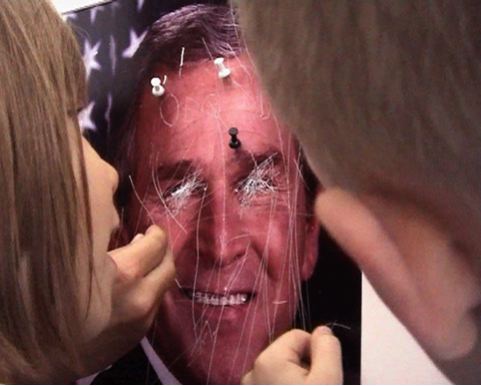
Did a change occur in the children's mind during or after the action?
It was a bit similar to the “Airplane Dripping“ exercise, they just went on until the whole picture was saturated. I asked them several times if they didn‘t think that it was enough a punishment now, but that excited them all the more. They repeatedly said, “he merits it“... that was pretty scary to me.
„We view things not only from different sides, but with different eyes; we have no wish to find them alike.“
Blaise Pascal
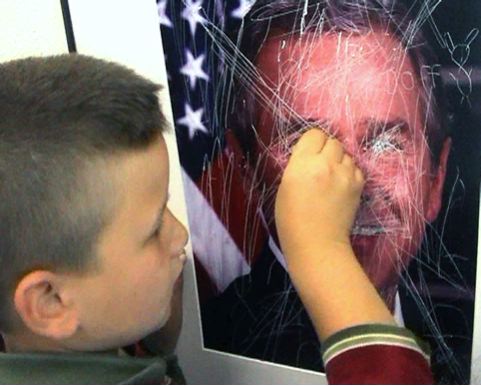
Would you say that you misused them? Did they express genuine opinions concerning George W. Bush - political opinions then -, would it be possible to realize this action with a portrait of any "evil man"?
Yes, I did misuse them. As I said before, they didn‘t even know who this person is, so they couldn‘t possibly express genuine political opinions. But that‘s not the point, I think. It is not necessary to understand something fully nor to express genuine political opinions in order to take part in a collective atrocity. There are other mechanisms and structures which determine our behaviour. This is the real problematic issue in my work, and I bet that it would have been possible to put a portrait of Mickey Mouse there instead and have the children act similarly. It got to the point where the oldest boy wrote “OAG“ on the portrait and spoke it out loudly: “Original amerikanischer Gangster“ (original American gangster). This sounds like a genuine political opinion, but in this case we know that it isn‘t. It reminds me of a scene that was frequently broadcasted on CNN (and on most TV channels in the world) just after September 11th, showing some Iraqi children and a couple of Iraqi women celebrating and burning the American flag on a street somewhere in Iraq.
„Anger as soon as fed is dead – 'Tis starving makes it fat.”
Emily Dickinson
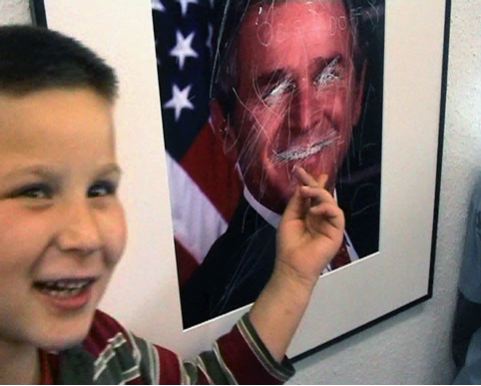
Was it fun for the kids? Or how serious was it, and did they understand it as an "art experience"?
It was for sure exciting for them and fun as well. They destroyed the picture consciously, focusing on the eyes and the mouth. They did it just after the outdoor painting experience, but I doubt that they considered the second action as an artistic experience. Actually most people wouldn‘t.
„That best portion of a good man's life, His little, nameless, unremembered acts of kindness and of love.”
William Wordsworth
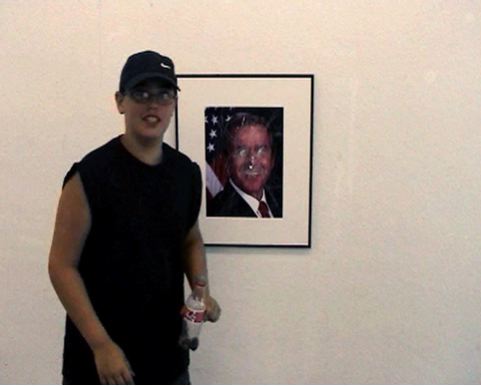
What did you intend to communicate about art? Are you conscious of a theoretical background or did you want to test something? And in this case, why did you choose to plunge right into the "political correct" mainstream? How far is it provocative at all, and why should it be?
I was interested in the idea of punishing a picture and in the idea of making ‘political art‘. If I would have made it by myself, it would have been boring and uninteresting. The way I got these children – which I didn‘t know before and had to sort of “kidnap“ from the playground – to perform makes it exciting and interesting for me. I think that I am very conscious of the theoretical level of the action, which could be somehow problematic in relation to the many practical and moral levels that are involved. Of course my choice of the picture is “mainstream“, because the power is mainstream, not underground. If you want to attack the power, you have to attack the mainstream. And to attack (symbolically) the leader of the number-one political and economical power in the world with a handful of children is a great pleasure for me.
„He to whom this emotion is a stranger, who can no longer pause to wonder and stand rapt in awe, is as good as dead: his eyes are closed.“
Albert Einstein
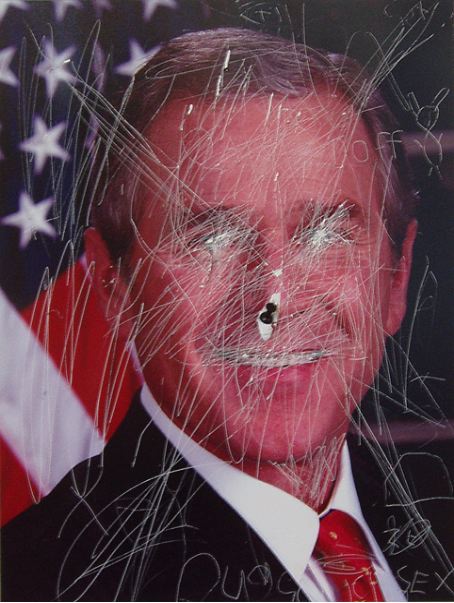
How long did the action take place?
About 20 minutes, I think.
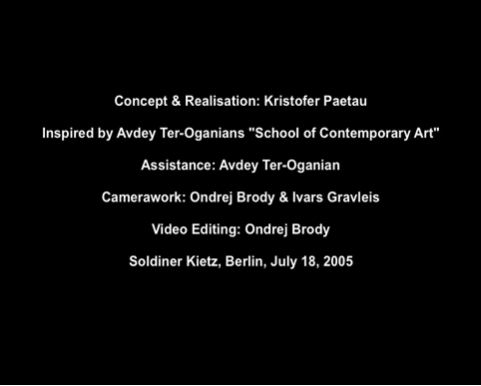
KIEZ AVANTGARDE KUNSTSCHULE, PART II: “The Punishment“
Concept & Realisation: Kristofer Paetau
Inspired by Avdey Ter-Oganian's “School of Contemporary Art“
Assistance: Avdey Ter-Oganian
Camerawork: Ondrej Brody & Ivars Gravleis
Video Editing: Ondrej Brody
Soldiner Kiez, Berlin, July 18, 2005
Interview: Heike Wetzig & Kristofer Paetau
Selected quotations by Rüdiger Heinze
August, 2005.
A Quicktime Videodocumentation is to be viewed at:
http://www.paetau.com/downloads/KiezAvantgarde/ThePunishment.mov
.